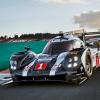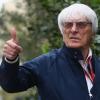At the start of the most recent season of Formula e, Jaguar signed Mitch Evans and Nick Cassidy as their two drivers. Perhaps the two standout drivers on the current Formula e grid (although Dennis, Wehrlein and Vergne continue to be on a very similar level), it was a mixture of perhaps the outright fastest driver in Mitch Evans, and the one with the most race intelligence (far more important in Formula e than Formula 1), in Nick Cassidy.
Fast forward to the last race of the season in London and the championship had been set up in about the best way possible, where if any of Cassidy, Evans or Pascal Wehrlein of Porsche won the race, they would be champion. And at the start of the race, they ran in that order, with the Jaguars first and second and totally in control of the championship decider. In Formula e, the drivers have to take two 'attack modes', which in the current generation of cars is more like the Joker Laps of World Rallycross where they take a wide line on one corner twice in the race.
At this point, Jaguar could have totally covered off Porsche by making Evans hold up Wehrlein while Cassidy takes both attack modes, then swap the cars and allow Evans to take both attack modes while Cassidy holds up Wehrlein. Then swap them back and allow them to fight fairly to the finish with Wehrlein having no way of getting ahead through strategy. They could even have then forced one driver to hold position to absolutely guarantee the championship barring a freak event but obviously that was never going to happen. Jaguar knew this was the best strategy as they had executed it perfectly in Monaco and secured a 1-2 finish.
Jaguar tried to play the same strategy again in London, but in a championship decider you are never going to be able to trust two drivers, each going for the championship, to follow the instructions, and on Cassidy's second attack mode attempt, Evans took the lead, with Wehrlein second and Cassidy down to third. From here, Jaguar were still in a good position as Evans had track position over Wehrlein, and both would eventually have to take the attack modes while Cassidy didn't, but Cassidy was now more vulnerable to an attack from those behind. And another quirk of Formula e is that the driver in first place uses more energy than those behind who can sit in the slipstream. This isn't as crucial in London as elsewhere as you can defend, but it still makes a difference and Wehrlein was better on energy than Evans as a result.
What ultimately happened was that Cassidy was hit from behind by Da Costa (teammate of Wehrlein, although while you can never know for sure, I don't think it was deliberate), giving him a puncture and putting him out of title contention when he was still in the best position to win it. Meanwhile, Evans made a mistake and missed the attack mode when trying to take it so lost out to Wehrlein, although it very much seemed as though the Porsche driver was going to get him anyway. Had Jaguar had one driver playing a supporting role, or even just two drivers happy to play fairly and trust each other fully to play fairly, they could have easily won the title. But having two number one drivers in the team ultimately cost them. It made me wonder whether teams in motorsport are better off having two lead drivers like Evans and Cassidy, or one clear number one and a supportive teammate in the style of Red Bull's current pairing in Formula 1, Max Verstappen and Sergio Perez.
There are probably four main ways of choosing a driver lineup for a team, anywhere on the grid. One is to just pick the two best drivers available, which might be the two best on the grid for a top team like McLaren in 1988 with Alain Prost and Ayrton Senna, or just the best two willing to sign for a midfield team, such as Alpine’s current lineup of Esteban Ocon and Pierre Gasly. A second option would be to have a lead driver and a loyal number two, in the style of Max Verstappen and Sergio Perez, Lewis Hamilton and Valtteri Bottas or Michael Schumacher and Rubens Barrichello. A potential third option would be to sign for the future, such as if Mercedes sign Kimi Antonelli in 2025 even though he will likely not be as quick as someone like Bottas in that first year, because in the long term it will surely pay off. The fourth option would be to have an underperforming pay driver like Nicholas Latifi or Nikita Mazepin to provide money to make the cars better, and help the teammate score more points.
For teams that struggle to get into the points, I think having one driver as someone providing lots of money is something of a no-brainer, as the team’s best results will come in random circumstances and the lead driver will almost always be there to pick up the pieces. In season five, NIO Formula e team signed Oliver Turvey, one of the best drivers at that time, and Tom Dillmann, who was just a step below, and Dillmann scored no points. In season six, they had Ma Qing Hua for half the season who scored the same number of points that Dillmann had but brought in a lot of money. Meanwhile, Turvey was the one always there to get a decent result when one was on the table. But as soon as the team starts being competitive enough to score points on a regular basis without needing freak circumstances, this strategy can be costly in the constructors’ championship and now it depends heavily on how much the team needs the money.
In the past, I think the best lineup for drivers was to have one lead driver and one up-and-coming talent. The Mercedes lineup of 1955 was the perfect example of this as Juan Manuel Fangio was the undisputed best in the world (after the death of Alberto Ascari), while Stirling Moss was clearly the next big thing, but he was happy to sit behind Fangio and learn from him. Mercedes pulled out at the end of the year so never got to reap the fruits of developing Moss. Another similar example would be the Tyrrell lineup of 1971-1973 where Jackie Stewart mentored Francois Cevert, and in their final season together, Cevert had almost reached Stewart’s level, before being killed in the final race of the season at Watkins Glen. McLaren are perhaps employing a similar strategy at the moment as Oscar Piastri develops and gets closer and closer to Lando Norris’ level.
But while Moss was initially not quite as fast as Fangio and improved while they were teammates, sometimes, and perhaps more often in recent years, the rookie driver can get on the pace more quickly and be more of a challenge to the lead driver. McLaren probably wanted Lewis Hamilton to support and learn from Fernando Alonso in 2007, but when Hamilton was almost immediately faster, this became more like a Senna/Prost lineup and caused significant tensions in the team and cost them the drivers, and arguably the constructors’ title. But they scored a lot more points that year than if it had been Pedro de la Rosa in the second McLaren.
In general, I think this tactic is quite good but building for the future is only really the way to go for top teams. If someone like Haas signed a driver who turned out to be a generational talent then they would get snapped up instantly by a team winning races. But sometimes they will get a good amount of time out of them, such as Williams in 2019-21 who only had George Russell while Mercedes were waiting to put him in their car, but got a lot more out of him than they would another option like Sergey Sirotkin who would have been a more long-term option. And even if they had had Russell for just one season, that would be better than choosing a worse driver just because they would have them for longer, when other better drivers could also become available in a year’s time. Similarly, there is no problem with Audi having Nico Hulkenberg and Valtteri Bottas in 2025 because, even if they won’t be there for a long time, for now they are still the two fastest drivers available and when they do start to decline, there will be plenty of replacements around. But for top teams, it is often best to get young drivers in earlier and plan for the future before other teams can take them. A prime example would be Max Verstappen choosing Red Bull over Mercedes because they were willing to give him a race seat earlier, or Oscar Piastri signing for McLaren rather than Alpine who wanted him to drive for Williams for a few years before going to Alpine.
But in general, the choice is between choosing the two best drivers available, or a clear first and second driver. In the midfield, if a team does not need to have a pay driver, I think that the first option is preferable. The current lineups at Alpine and Williams are a good example of this, as they have similarly matched cars, but while Ocon and Gasly are the most evenly matched teammates on the grid, Albon, who is on a similar level to the Alpine teammates, is still yet to be outqualified by Sargeant. It is perhaps as extreme an example as it gets in the midfield as Ocon particularly seems dead set on beating Gasly and they have collided on multiple occasions, most notably in Monaco but they also cost each other time in Austria this year. But despite this, Alpine have more points than Williams in the championship, and if the cars had been equal at every race I would expect that trend to be the same as Sargeant is not contributing any points. Albon may beat Ocon and Gasly in the drivers’ title by having less internal team battles, but in the midfield the constructors’ title is far, far more important. Also, Alpine know Ocon and Gasly are effectively equal drivers so can try different parts or setups on different cars and discover which is better, whereas if Williams tried the same with Albon and Sargeant the results are more likely to be misleading.
In a situation where a team is dominating Formula 1, I think it is clearly better to have one world champion level driver and one support act. Since all the problems caused by the Ayrton Senna and Alain Prost lineup at McLaren in 1988-1989, other teams seem to agree with that assessment with McLaren signing Berger to replace Prost in 1990, Williams having Patrese with Mansell in 1992 and rookie Hill with Prost in 1993, McLaren having Coulthard who wasn’t on Hakkinen’s level and Barrichello joining Schumacher at Ferrari. Fisichella couldn’t challenge Alonso at Renault, and Webber came close in 2010 due to better luck but in general was nowhere near Vettel at Red Bull. Bottas was the perfect wingman for Hamilton at Mercedes after the tensions with Nico Rosberg, and now Sergio Perez is playing a similar role for Max Verstappen at Red Bull. In some of those situations, there was only one standout driver of the era and no obviously better driver to pair with the dominant champion, such as the early 2000s when Schumacher was in a class of his own, while Red Bull wanted Norris but he felt he had a better chance at McLaren (at the time I thought this was the wrong decision by Norris but he is fast proving to have made a brilliant call). But Prost vetoed Senna as his 1993 teammate, Alonso was available for the 2017 Mercedes lineup, and Hamilton reportedly tried to join both Vettel and Verstappen at Red Bull but had his approaches rejected in 2011 and 2023 respectively, so the teams are usually picking these lineups out of choice. And when they are far enough ahead to win both championships comfortably anyway, nobody can blame them because there is no point causing tensions in the team with two top drivers. Perhaps the greatest number two ever was Ronnie Peterson, who was probably as fast as Mario Andretti but at Lotus in 1978 was very happy to play the support role and finish second to him.
But when a team is in a championship battle, I think it pays to have the two best drivers available in almost all circumstances. The main reason for this is that, while fans focus most on the drivers’ title, for teams the constructors’ title is just as important and you have a much better chance of winning that with Senna and Prost than Verstappen and Perez, if the car is not dominant. Red Bull look likely to lose the constructors’ title in 2024 because of Perez not contributing enough points, even though Max Verstappen will surely be world champion. But there are other factors contributing to Perez’s contract extension, and I think the main one is knowing that Red Bull have to keep hold of Verstappen and doing anything to risk him leaving the team, such as dropping Perez and signing the best driver out of contract and seemingly obvious replacement in Carlos Sainz, would not be worth it.
But even just focussing on the drivers’ title, having a faster second driver can often be preferrable, as they can be helpful for the strategy of the lead driver. Sergio Perez was close enough to Lewis Hamilton to hold him up after the pitstops in Abu Dhabi 2021, but on that day, Valtteri Bottas was off form and couldn’t do the same to Max Verstappen. In Spain 2021, it was the other way around as Hamilton was able to make an extra stop to chase down Verstappen because it was Bottas who was close, rather than Perez. In a very similar race to Spain, Lewis Hamilton made a late pitstop to hunt down Max Verstappen in Hungary 2019 and passed him at the end for victory. He could have been prevented had Pierre Gasly in the second Red Bull been within a pitstop of Hamilton, but instead he was stuck behind midfield cars, and one race later was driving a Toro Rosso. One very unusual but perfect situation a team can get is if the support driver is actually the best on the grid, such as when Michael Schumacher returned from injury at Malaysia 1999 to help Eddie Irvine, or when Steve Soper did a part-season for BMW in 1992 and helped Tim Harvey win the title by slowing down John Cleland (and then taking him out). But had Schumacher or Soper done the full season, they would probably have won those titles easily which would have been much better for those teams than it going to the final race.
Sometimes the strategy of having two superstars is criticised because they take points off each other. It is true that, had Hamilton been allowed to win Malaysia, Monaco or Monza in 2007 instead of Alonso he would have been world champion. Or if Alonso had taken Indianapolis, it would have been him. But had Pedro de la Rosa been driving the McLaren instead of one of them, he may also have finished behind the Ferraris in some of those races so gifted points to Raikkonen as well. And sometimes you can choose the wrong driver to back, as McLaren did seem to want Alonso to win in Monaco 2007 which turned out to be a mistake. Similarly, Williams ordered Carlos Reutemann to let Alan Jones win in Brazil 1981, and Reutemann, who refused, ultimately came closer to winning the championship, albeit with a bit of luck. Red Bull made the bold call to allow Vettel to win Brazil 2010 even though Webber was closer to Alonso, a call that ultimately won them the championship. Having two top drivers increases the chance that one of them will be close at the end of the season, sometimes not the driver you would expect as results can be affected by good luck for Reutemann in 1981 and Webber in 2010, or one driver being better than expected like Mansell in 1986 or Hamilton in 2007. You would hope that if one driver drops out of contention, then they would eventually become helpful. Gordon Shedden and Matt Neal in BTCC were a perfect example of this as they would do anything to help the other win the championship if it came down to it despite starting the season as rivals, and were one of the finest teammate pairings in any motorsport as a result, despite one disastrous moment when Neal took out Shedden when they were running 1-2 at the final corner at Oulton Park in 2011.
Jaguar could have stuck with Sam Bird as the second driver in Formula e this year, as he would not have fought Evans or Cassidy for the title and would have been happy to play a support role in London. But arguably the only reason that Jaguar found themselves in such a commanding position in that race was that they had two top drivers who were both capable of winning. Maybe Bird or any other support driver would not have been in position to slow down Wehrlein and give Evans or Cassidy the space for two attack modes, and then protected him, because they would have qualified mid-pack. And even though Jaguar threw away their dominant position when Evans didn’t leave enough space for Cassidy to take the second attack mode, they were still comfortably the favourites to win at that time, as Cassidy would have cycled back to the front when Evans and Wehrlein did eventually take those attack modes had he not been taken out. And even then, Evans might have been able to hold off Wehrlein had he not made a mistake. Everything had to go wrong for the title to slip through Jaguar’s fingers, and it did. Another thing to note is that if Jaguar had kept Sam Bird, then Nick Cassidy might have remained at Envision and won the championship for them instead. Or either driver could have had a particularly unlucky season so it would have been good to have two eggs in the potential champions basket. Evans and Cassidy also helped each other out to get the 1-2 back in Monaco, and less successfully in Berlin, so might not have even gone into that race so close to the title had they not had those two top drivers. And most crucially of all, Jaguar still won the constructors’ championship because of the combined points totals of Evans and Cassidy.
So the London e-Prix might have appeared to have demonstrated the flaws in signing two top drivers as teammates. But I think that the lineup of Mitch Evans and Nick Cassidy gave Jaguar the best possible chance of winning the championship this year and was absolutely the right decision.
























